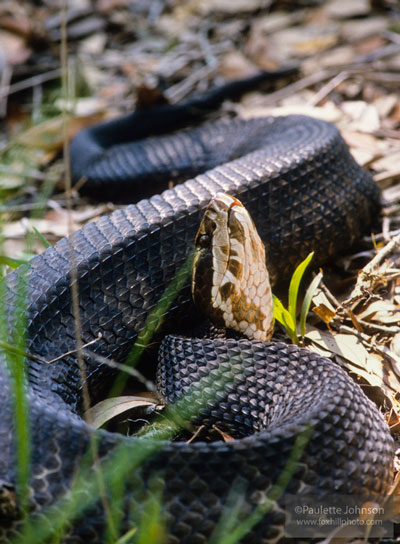
In many regions, summer is the time when snakes are the most active, although snake activity can pick up in the fall as temperatures start to drop and snakes come out for warm sunshine before their season of hibernation starts. They tend to be more common in rural areas—like where you may have your horse stabled. Even if you’re not afraid of snakes, seeing one slither out in front of you on the trail can be startling—for you and your horse. Let’s take a quick look at some ways to help avoid snakes around your horses, and we’ll explore what to do if your horse comes in contact with one of these reptiles.
Types of Snakes
| SNAKE | REGION |
|---|---|
| Cottonmouth | Southeast U.S. |
| Copperhead | Southeast U.S. |
| Coral | Southern U.S. |
| Rattlesnakes (various types) | Widespread throughout the Pacific Coast, Rocky Mountain Regions, and Eastern U.S. |
Snakes on the Trail
Trail riding in snake country? Consider trying the following:
◆ Use leg wraps. If you’re trail riding in an area prone to snakes, you can try wrapping your horse’s legs with lower leg wraps thick enough to prevent a bite.
◆ Avoid brush. This isn’t always possible, but if you can stay in open country and avoid thick grass or brush where you can’t see the ground, you and your horse will have a better chance at avoiding snakes to begin with. Snakes are almost certainly not seeking out you or your horse; many snakebites occur when the snake is surprised.
◆ Protect yourself. Be sure that you wear boots and leg protection to help prevent snakebites.
◆ Listen! If your horse hears something, stop and take a listen with him! He can spot a snake better than you can.
Snakes in the Barn
Want to keep snakes away from the barn and pastures? No problem. The key is to eliminate things that snakes are attracted to. These include:
◆ Rock piles. Snakes are coldblooded, so they have to seek out warm areas in their environment to help heat up their bodies. Rock piles tend to hold warmth from the sun, and they provide a million little tunnels and hideouts for snakes, so removing rock piles is a smart move.
◆ Other piles. It’s also smart to remove general piles of materials like lumber, fence posts, or pallets, for the same reason.
◆ Tall grass. When snakes are startled, they often make an immediate run for the nearest area of deep grass or brush. Keeping these areas mowed and the exterior of your stable trimmed down will help discourage snakes from hanging out around the stable.
◆ Rodents. Many snakes prey on small critters like mice, so keeping those populations under control may discourage snakes (and you don’t want rodents around your barn anyway).
Snakes in the Horse Trailer
Most horse trailers don’t see use every day, or even every week. So it’s possible that an enterprising serpent might decide to take up residence in such a handy shelter. You can take a few simple steps to help avoid having a snake in your horse trailer, such as:
◆ Keep it cleaned out. Just like around the stable, a snake is probably less likely to hide in a clean horse trailer, because there isn’t anywhere for him to take cover. And if you do remove any old hay, bedding, or gear from your trailer after a ride, it’s easy to see if there is a snake inside next time.
◆ Check underneath. Be sure to look under the horse trailer before using it!
Park it indoors. You might not have space for your trailer indoors, but if you can get it inside a garage or pole building, you have another barrier between it and snakes.
If a Bite Does Occur
If a snake does bite your horse, here are a four basic tips:
◆ Don’t panic. Call your horse’s veterinarian and follow their advice precisely while you wait for help to arrive. Try to keep your horse calm, as extra activity can make the venom spread faster. Keep in mind that venomous snake bites in horses are less frequently fatal because of the horse’s larger size. But horses may still suffer severe allergic reactions or infections at the bite site.
◆ Try to find the bite location. Your veterinarian may supply specific first aid instructions depending on the bite’s location—especially if the bite is on your horse’s nose (that’s a very common spot) where the swelling could affect breathing.
Identify the snake. It’s helpful if you can safely identify the snake species, but don’t put yourself at risk to do so.
◆ Follow instructions. After the veterinarian arrives, precisely follow their advice for post-bite care.
Oftentimes, snakes are simply part of the outdoor experience, like bugs or thunderstorms. And they’d really rather stay away from you as much as you’d like to stay away from them. But it pays to think ahead, do a little research, and be prepared. Hopefully, the closest you and your horse ever get to a snake is viewing one as it casually slides away in the other direction.






